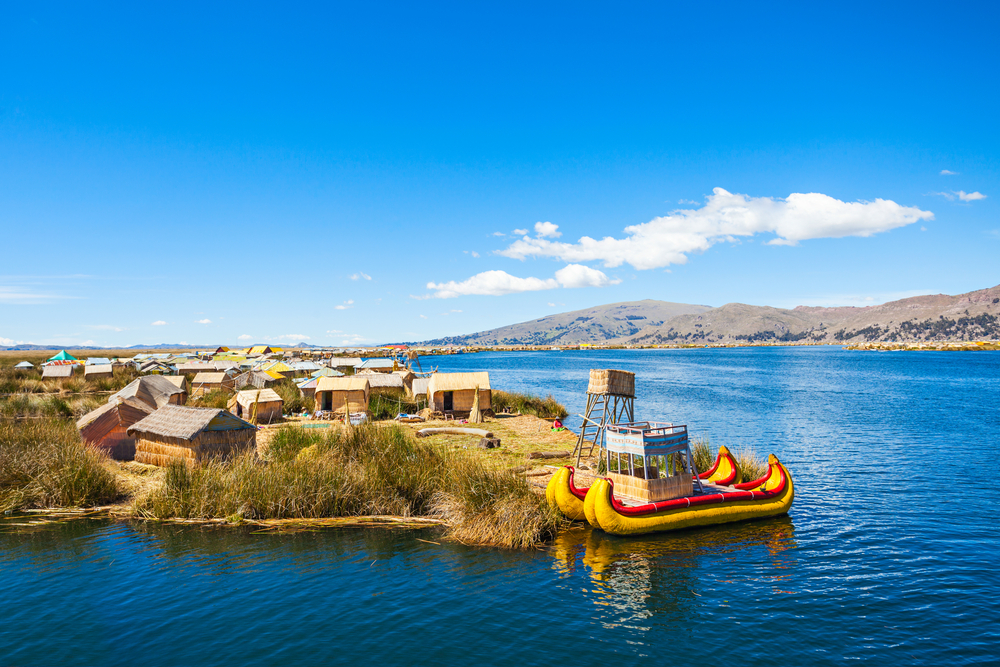At an impressive elevation of 3,810 meters (12,500 feet) above sea level, Lake Titicaca in the Andes Mountains of South America is widely considered to be the world’s highest lake. In actuality, this famous body of water is trumped by 14 higher elevated lakes, the highest of which sits over 2,500 meters (8,200 feet) above Lake Titicaca.
Despite not technically being the world’s highest lake, Lake Titicaca is the world’s highest lake that is navigable to large vessels, and is the world’s largest alpine lake. The 8,300-square-kilometer (3,200-square-mile) stretch of water is South America’s second-largest lake after Lake Maracaibo. But it’s Andean neighbour, Ojos del Salado, towers over Lake Titicaca, sitting at an elevation of 6,390 meters (20,965 feet) above sea level.
Ojos del Salado
While its surface area is puny by comparison, covering around 100 meters (328 feet) in diameter, Ojos del Salado sits 6,390 meters (20,965 feet) above sea level – that’s almost eight times the height of the Burj Khalifa, the world’s tallest building. The area surrounding the lake makes up part of a vast volcanic structure in the High Andes that is also home to the world’s highest volcano.
Reaching heights of 6,879 meters (22,569 feet) in places, the dormant Ojos del Salado volcano was active during the Pleistocene and Holocene when lava flow created mounds and depressions, some of which eventually filled with water and formed lakes.
Lake Titicaca
While the famous Lake Titicaca is knocked off the top spot as the highest elevated, it is still an impressive and complex geological feature that is also home to many native communities. Stretching for a distance of 190 kilometers (129 miles), the lake receives water from more than 25 rivers, with two-fifths of the entire basin coming from one single river: the Ramis.
With a depth between 140 and 180 meters (460 and 600 feet), the lake is also home to 41 individual islands, some of which are densely populated. Roughly 4,000 people inhabit these islands, with the Uro tribe, who predate the Incan civilization, having preserved much of their traditional way of life.
The largest of the lake’s islands is Isla del Sol which stretches across 14.3 square kilometers (5.5 square miles). Taking its name from the Temple of the Sun, believed to be where the founders of the Inca dynasty were sent by the sun god, the island is home to many ancient structures including the two-story, 15- by 13-meter (50- by 43-foot) Inca’s Palace.

The Uros islands floating in Lake Titicaca.
Image credit: saiko3p / Shutterstock.com
Other impressively high lakes
The majority of these elevated lakes are formed from volcano craters and sit in the Himalayas in Asia and in South America, home to two of the world’s tallest mountain ranges. Along with Lake Titicaca and Ojos del Salado, South America is also home to Chile’s Lake Licancabur. The world’s ninth-highest lake, Lake Licancabur possesses high levels of ultra-radiation that creates an environment similar to the surface of Mars.
Chile’s second-highest lake, at an altitude of 6,206 meters (20,361 feet), sits atop the Nevado de Tres Cruces volcano which last erupted 28,000 years ago. The area is famous for its scuba diving expeditions deep into the lake’s waters.
The Himalayas’ highest lake was once found a few miles north of Mount Everest at an elevation of 6,368 meters (20,892 feet). Recent satellite imagery suggests, however, that what was once the second-highest lake in the world has now dried up and is considered extinct.
Despite their extreme conditions, many of the world’s highest lakes, including Ojos del Salado, are popular tourist destinations, with local communities encouraging hiking and sightseeing. It is, however, always important to seek advice from experienced local guides and be aware of the different features’ geological quirks.
Source Link: The World’s Highest Lake Isn’t Lake Titicaca